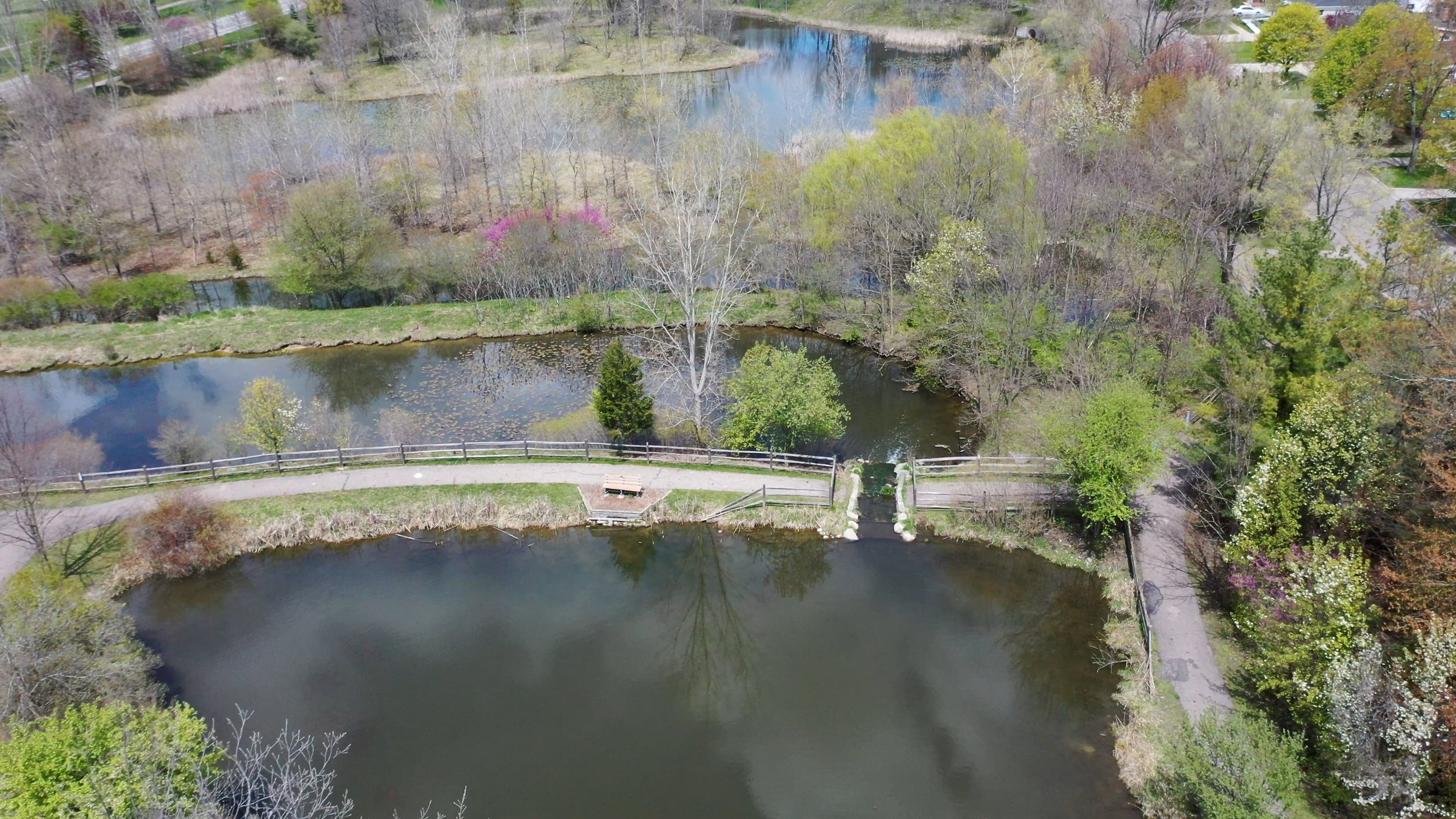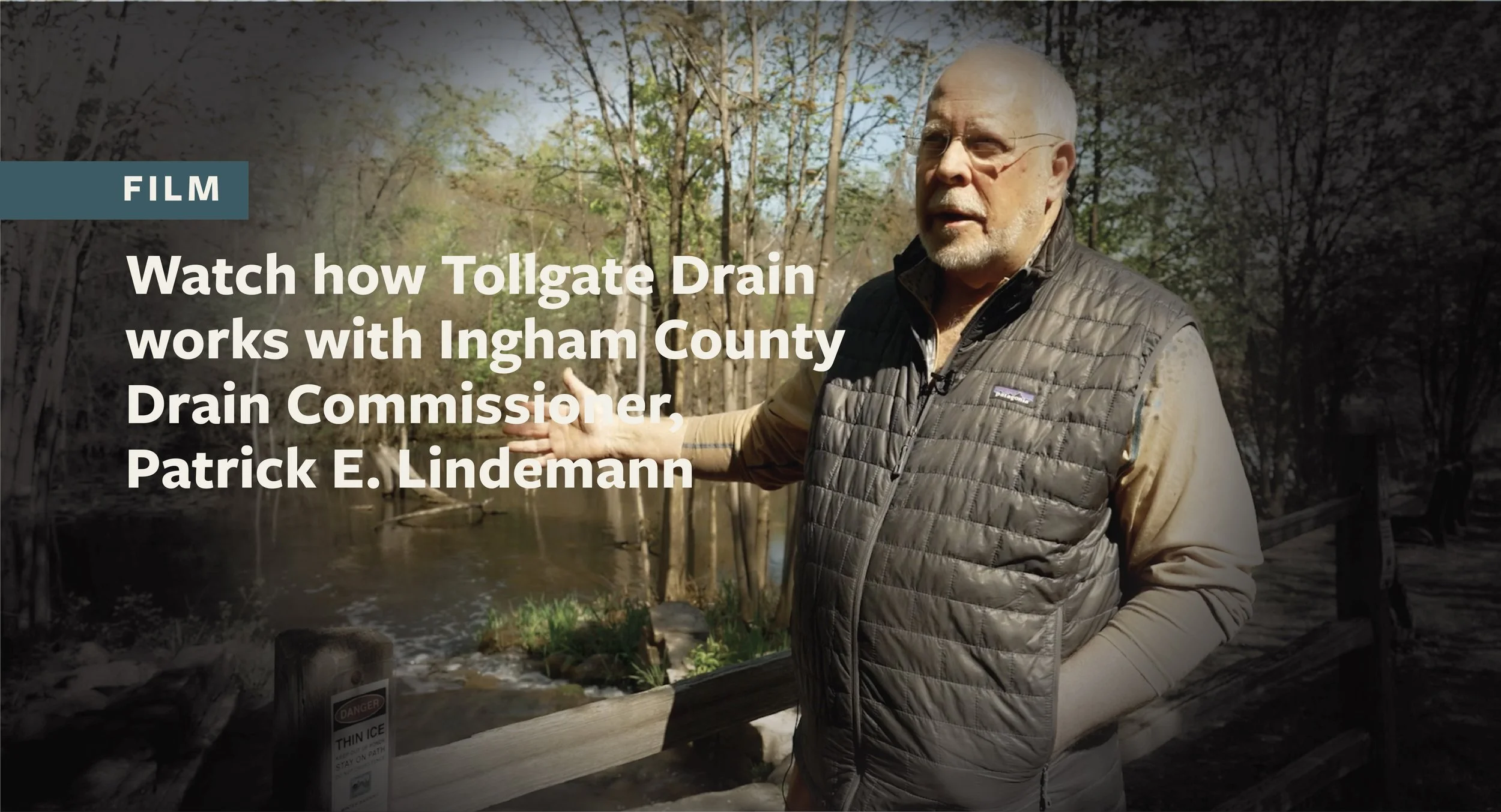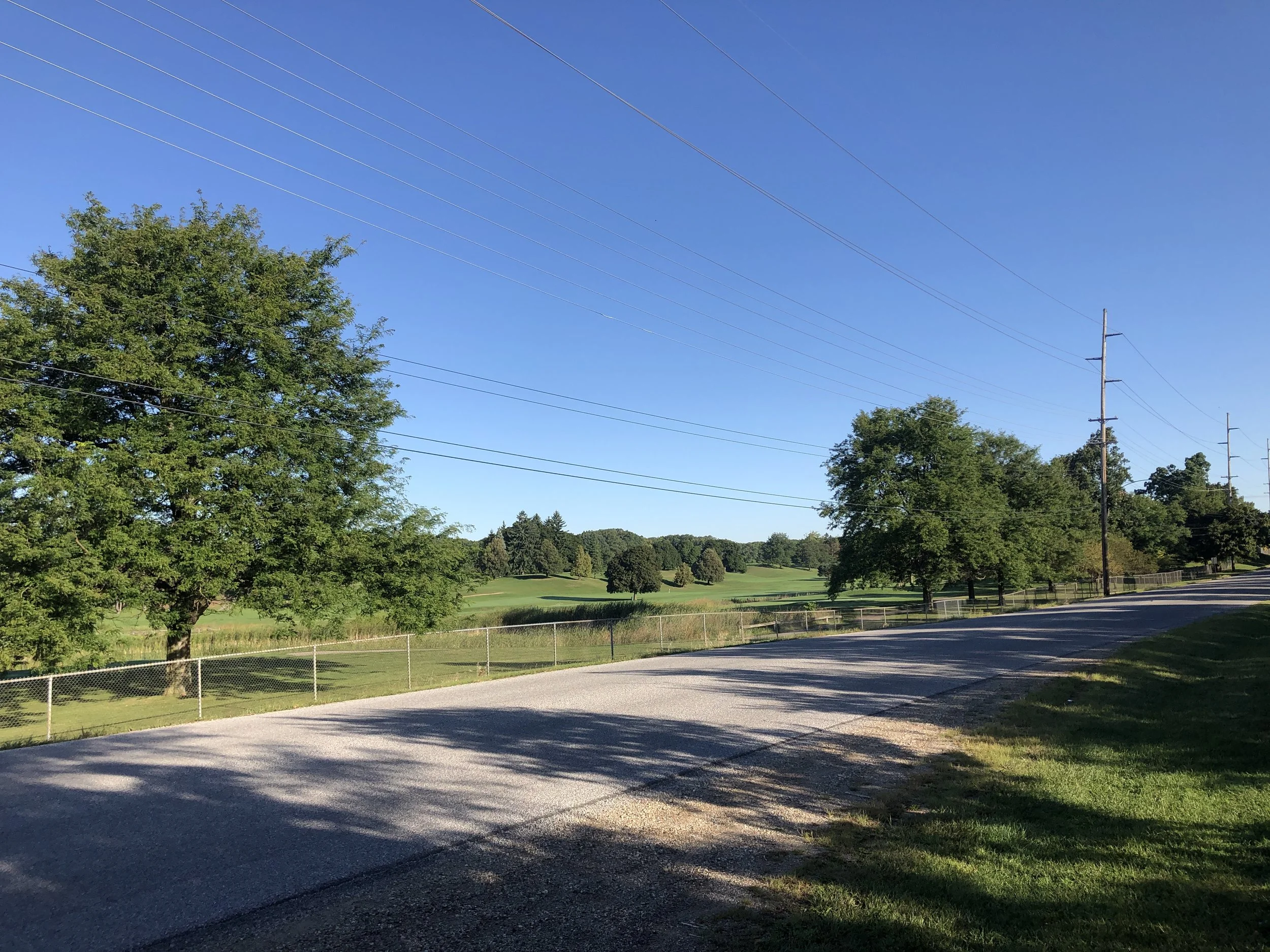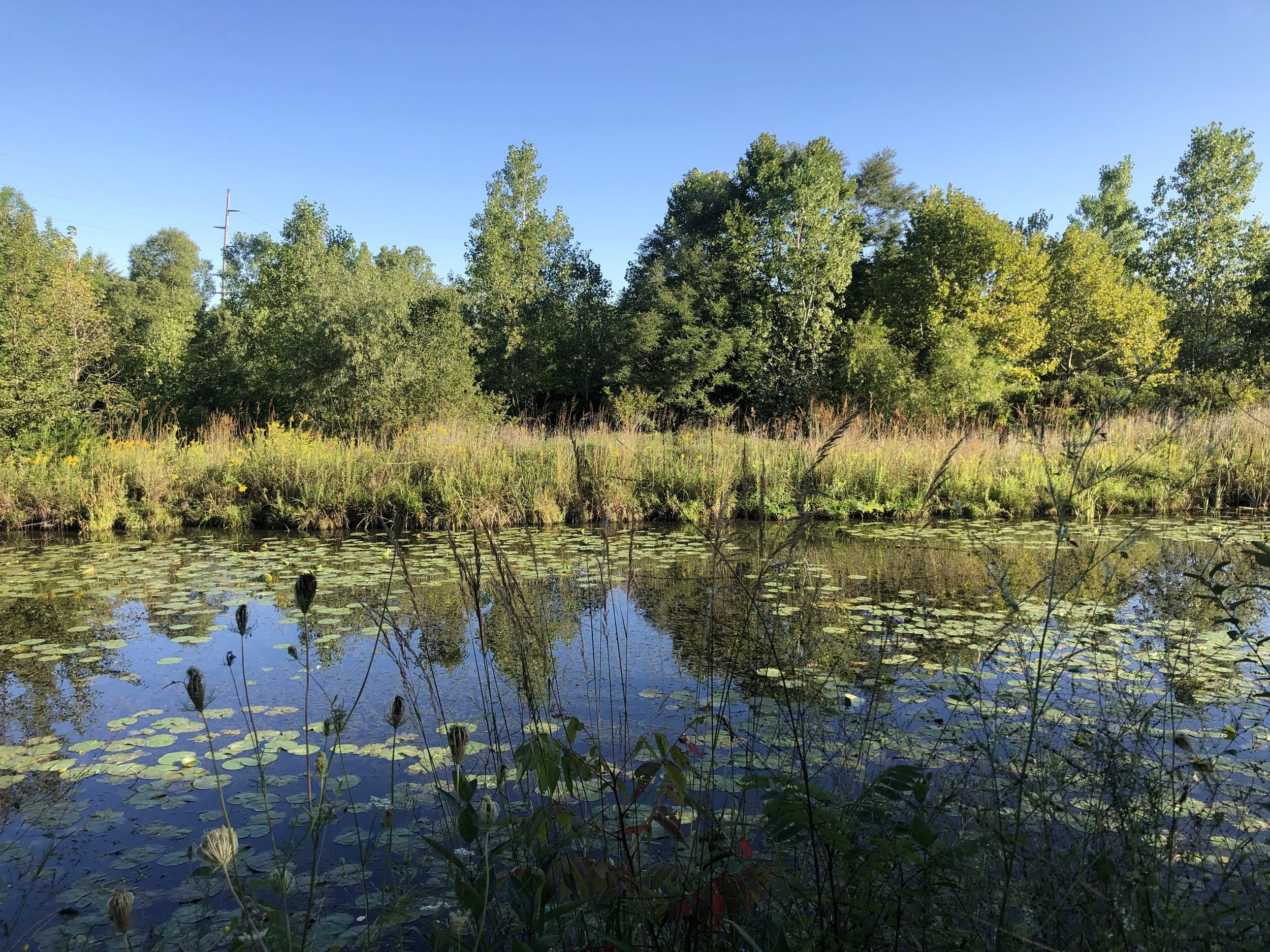
Tollgate Drain
Fondly called Tollgate Wetlands by locals, Tollgate Drain solves a combined sewer overflow problem using a low impact design, saving millions of tax dollars and providing the neighborhood a peaceful respite in the city.
Tollgate Drain wildlife caught on camera
Cascading water over limestone puts dissolved oxygen into the water, breaking down a variety of contaminants.
These limestone cascades are the first three limestone waterfalls in the Tollgate Drain’s treatment train. Churning water over the cascades incorporates dissolved oxygen into the water, which breaks down a variety of contaminants. Limestone, or calcium carbonate, is a base that that buffers acidity in the water to ensure the pH remains neutral. Additionally, limestone can be effective in removing metals dissolved in water due to ion exchange. More than an attractive water feature, the cascades are a central part of the ecosystem.
Flooded trees die and become part of the decomposing community. This decaying wood harbors the bacteria necessary to break down organic waste, hydrocarbons and contaminants.
After rushing over the limestone cascades, water travels into the deadwood forest. This swamp-like habitat provides shelter for owls, woodpeckers and other birds. The flooded trees will die and become part of the decomposing community. This decaying wood harbors the bacteria necessary to break down organic waste, hydrocarbons and contaminants.
The water in this pond is approximately 4.5 feet deep in the center. Debris in the bottom of the pond builds a habitat for healthy bacteria. The pond elevation is designed to send water over more limestone cascades for the next phase of cleaning.

A closer look at Tollgate Drain
Download interpretive trail signs found along the walking path at Tollgate Drain or take a virtual tour!
(Best viewed on a desktop computer)
Red-winged blackbirds nest in Tollgate Drain
Aquatic plants clean the water and aid in evapotranspiration.
Water flows over limestone into the top of this bell-shaped pond at a relatively high velocity, but it slows down as the pond widens. Suspended solids in the water are then able to settle to the bottom of the pond. At the same time, specially selected aquatic plants act as filters.
Just like a furnace filter cleans the air, aquatic plants clean the water. Plants like lily pads, cattails, bladderwort cardinal flowers and sedges were incorporated into the Tollgate Drain’s ecosystem for their ability to absorb water and moderate its acid and nutrient levels. These aquatic plants also aid in evapotranspiration, which is when water travels through plants and evaporates into the atmosphere.
All the ponds are lined with layers of materials that stop water from filtering into the earth.
This entire system of ponds exists to capture storm water runoff that is contaminated and provide a treatment train rather than let it seep into the ground. The goal is to store storm water and clean the water so it does not pose a public health threat. All the ponds are lined with layers of materials that stop water from filtering into the earth. The peat filter starts from the bottom layer with a dense clay, then an impenetrable layer of rubber beneath crushed limestone, permeable cloth, sand, a 50/50 sand/peat mix and finally a layer of pure peat on top.
The peat filter is very wide, approximately 2-3 feet deep, and lower in elevation than the upper ponds. This allows the water coming from the bell-shaped pond to slow down and spread out so pollutants can settle to the pond floor.
The wetlands are constructed to recycle water, moving it through the various ponds. Evaporation is encouraged since the water is always moving. It also means the water rarely freezes over in the winter; salt from the roads also contribute to this. The plant life at the Tollgate Drain is salt tolerant.
A special structure built to protect Blanding’s turtles’ nests from predators who would eat the turtles’ eggs.
Large trees and wooded spaces make a more stable and complete ecosystem. Forests help maintain elevation changes and help direct the flow of water into the lower ponds. The leaf canopy of the trees supply a large surface area for raindrops to land and evaporate during a small rainstorm. In a larger rainstorm, the canopy slows down the energy of each raindrop as it falls to the ground, helping to reduce erosion and swift storm water runoff caused by falling rain.
Blanding’s turtles, which are protected by the order of the Michigan Department of Environment, Great Lakes, and Energy, need wetlands to survive and use the Tollgate Drain habitat for breeding and shelter. There’s even a special structure built to protect nests from predators who would eat their eggs.
The plants, ponds, trees and wildlife here are designed as a system to manage storm water and reduce pollution. A simple pond in a field would not be able to accommodate as much water, nor reduce pollution in the same way. Traditional engineering solutions would cost more and work less efficiently with less success.
Varying depths of the ponds help encourage the water to circulate around a small island. This active current encourages evaporation, which helps keep water levels manageable.
While this looks like one large pond, it is actually three ponds with varying depths. Water flows into these ponds from the spreading ditch, and the varying depths help encourage the water to circulate around the small island, almost like an underwater stream. This active current encourages evaporation, which helps keep water levels manageable. An inlet from the neighborhood is located North of the turtle breeding cage, where pumps send stormwater to the upper waterfalls located on the West side of the lower ponds. Water levels exceeding the capacity of the upper waterfalls overflow to the golf course.
When rain levels are normal, water is pumped straight to the limestone cascades to start the filtering process. But during heavy storms, water flows directly into this space from a 60-inch drainpipe in the Northeast corner of the lower ponds. The system is built so neighborhood homes do not flood during heavy rain. How is this possible? The overflow to the golf course is lower than the lowest basement found in the neighborhood, offering stormwater an alternative route, protecting each home from flooding.
To isolate some of the wetland from human disturbance, an island of mature vegetation was left alone in the middle of the lower ponds.
To isolate some of the wetland from human disturbance, an island of mature vegetation was left alone in the middle of the lower ponds. Nesting boxes and bat houses were installed to attract wetland birds and bats, and you can frequently see ducks and blue herons, as well as deer that pass through the area. A live catch-and-release program is in place to control populations of mammals like the muskrat.
By the time water reaches these ponds, it has been cleaned of approximately 88% of polluting chemicals, including total suspended solids, some nutrients, metals and organic contaminants. The dissolved oxygen in the Tollgate Drain system is comparable to trout streams in Northern Michigan.
Fewer trees were planted along Wood Street so wind coming from the southwest can blow over the wetlands, helping to evaporate water and keep it at manageable levels.
A 500-year storm is a storm that has a 0.2% chance of occurring any year. These storms tend to be higher intensity and have large volumes of rain rather than a typical summer rainstorm. Before the Tollgate Drain was designed, excess water made its way, pollution and all, to the Red Cedar River. Now, by sending excess water to the Groesbeck Golf Course, this drain can even manage the water from a 500-year storm without any adverse effects to homes in the neighborhood. We redesigned the front nine holes of the golf course to do this, adding water features and landscaping—which is both useful and beautiful.
There are fewer large trees on Wood Street. This is so wind coming from the southwest can blow over the wetlands, helping to evaporate water and keep it at manageable levels.
The wide leaves on these lily pads transpire about 10,000 gallons of water a day during warmer months.
The wide leaves on these lily pads transpire about 10,000 gallons of water a day during warmer months, making them one of the most useful plants you see here. That’s enough water to fill a medium-sized swimming pool every single day.
You’ll often see plant vegetation such as swamp milkweed, switchgrass, common boneset, and spotted jewelweed along lakes and creeks, or in Michigan yards. It often does a better job filtering water and stabilizing the soil than non-native plants would.
Trees such as the Gray Osier Dogwood stabilize soil on the banks, which controls erosion. The tree’s berries provide food for birds and other wildlife.
Inspired works by Patrick E. Lindemann, Ingham County Drain Commissioner, celebrating Tollgate Drain’s completion.

Awards Received
Michigan Section of the American Society of Civil Engineering Honorable Concept Award
Tollgate, City of Lansing and Lansing Township, 1999
Keep Michigan Beautiful Award
Fairview Park Stormwater Cleansing Basin in Tollgate, 1998
Michigan Association of County Drain Commissioners Urban Stormwater Management Award
Tollgate, 1997




















